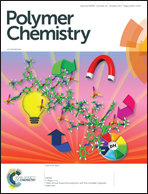Photosensitive polydimethylsiloxane networks for adjustable-patterned films†
Abstract
Polydimethylsiloxanes (PDMSs) bearing photoreactive coumarin groups have been synthesized by amidation of a coumarin acid chloride derivative with various amine-functionalized PDMSs. Upon exposure to UV light having a wavelength of above 300 nm, multifunctional coumarin-PDMSs are transformed into covalent networks via [2 + 2] photocycloaddition of two coumarin moieties forming a cyclobutane ring. Taking advantage of the possible localized irradiation through a photomask, a novel concept to generate patterned PDMS films with various surface topologies was demonstrated. This concept is based on the combination of a low molar mass difunctional PDMS with a multifunctional PDMS of a high molar mass forming a photoreversible network allowing osmotic diffusion of a linear PDMS-coumarin of low molecular weight in a loosely crosslinked network. Advantageously, illumination by a light source at 254 nm induces the photocleavage of the cyclobutane cross-links offering some photo-induced reversibility to the PDMS network. These novel photo-responsive networks are interesting for several applications, in photo-adaptable biomedical implants (particularly photo-adjustable intra-ocular lenses), photo-tuneable patterned microsystems (e.g. for microfluidics) and photo-switchable controlled release systems.



 Please wait while we load your content...
Please wait while we load your content...